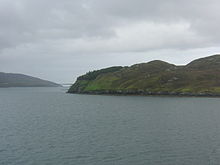| Scottish Gaelic name | Sgeotasaig |
|---|---|
| Location | |
| OS grid reference | NG185975 |
| Coordinates | 57°53′N 6°45′W / 57.88°N 6.75°W |
| Physical geography | |
| Island group | Lewis and Harris |
| Area | 49 ha |
| Area rank | 205= [1] |
| Highest elevation | 57 m |
| Administration | |
| Council area | Na h-Eileanan Siar |
| Country | Scotland |
| Sovereign state | United Kingdom |
| Demographics | |
| Population | 0 |
| References | [2][3][4] |
Scotasay (Scottish Gaelic: Sgeotasaigh) is small island in the Outer Hebrides of Scotland. It lies 1 kilometre (0.6 miles) off the east coast of Harris and gives some shelter to the ferry port of Tarbert. There are two houses on the island, a wind turbine and a fresh water tank.[5]
The island had 15-20 inhabitants in the early 20th century but there are no records of any permanent inhabitation since then.[3]

References
[edit]- ^ Area and population ranks: there are c. 300 islands over 20 ha in extent and 93 permanently inhabited islands were listed in the 2011 census.
- ^ National Records of Scotland (15 August 2013). "Appendix 2: Population and households on Scotland's Inhabited Islands" (PDF). Statistical Bulletin: 2011 Census: First Results on Population and Household Estimates for Scotland Release 1C (Part Two) (PDF) (Report). SG/2013/126. Retrieved 14 August 2020.
- ^ a b Haswell-Smith, Hamish (2004). The Scottish Islands. Edinburgh: Canongate. pp. 274–275. ISBN 978-1-84195-454-7.
- ^ Ordnance Survey. OS Maps Online (Map). 1:25,000. Leisure.
- ^ Scotasay Dualchas. Retrieved 3 January 2022.
57°52′40″N 6°45′00″W / 57.87790°N 6.75013°W


Well, that’s interesting to know that Psilotum nudum are known as whisk ferns. Psilotum nudum is the commoner species of the two. While the P. flaccidum is a rare species and is found in the tropical islands. Both the species are usually epiphytic in habit and grow upon tree ferns. These species may also be terrestrial and grow in humus or in the crevices of the rocks.
View the detailed Guide of Psilotum nudum: Detailed Study Of Psilotum Nudum (Whisk Fern), Classification, Anatomy, Reproduction